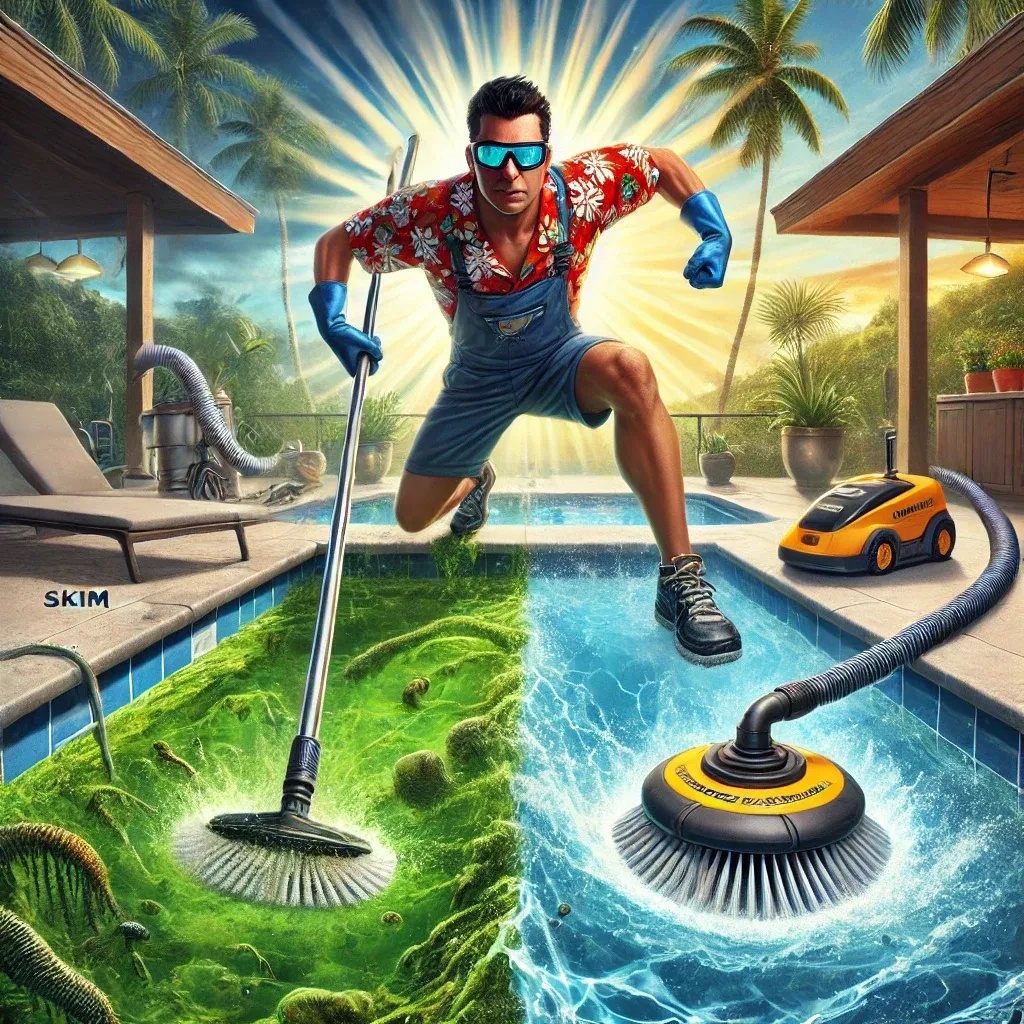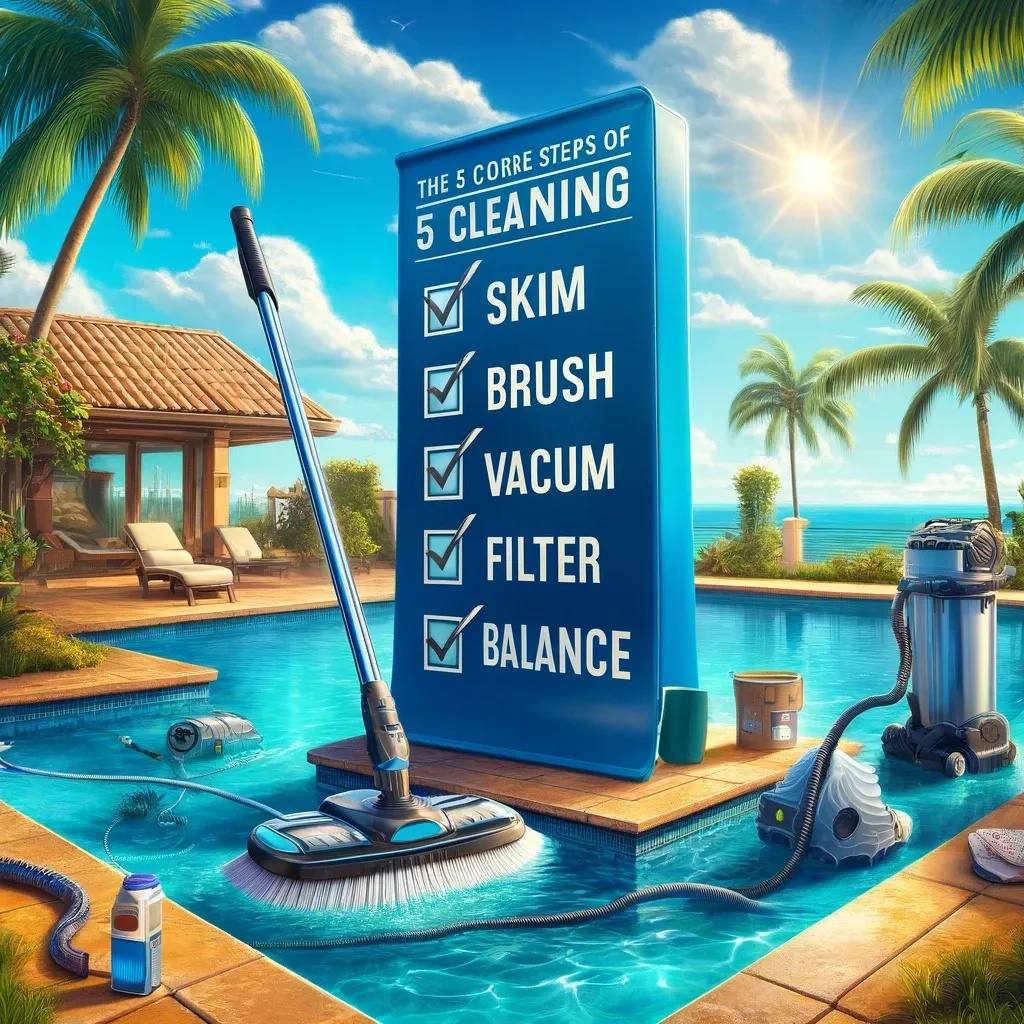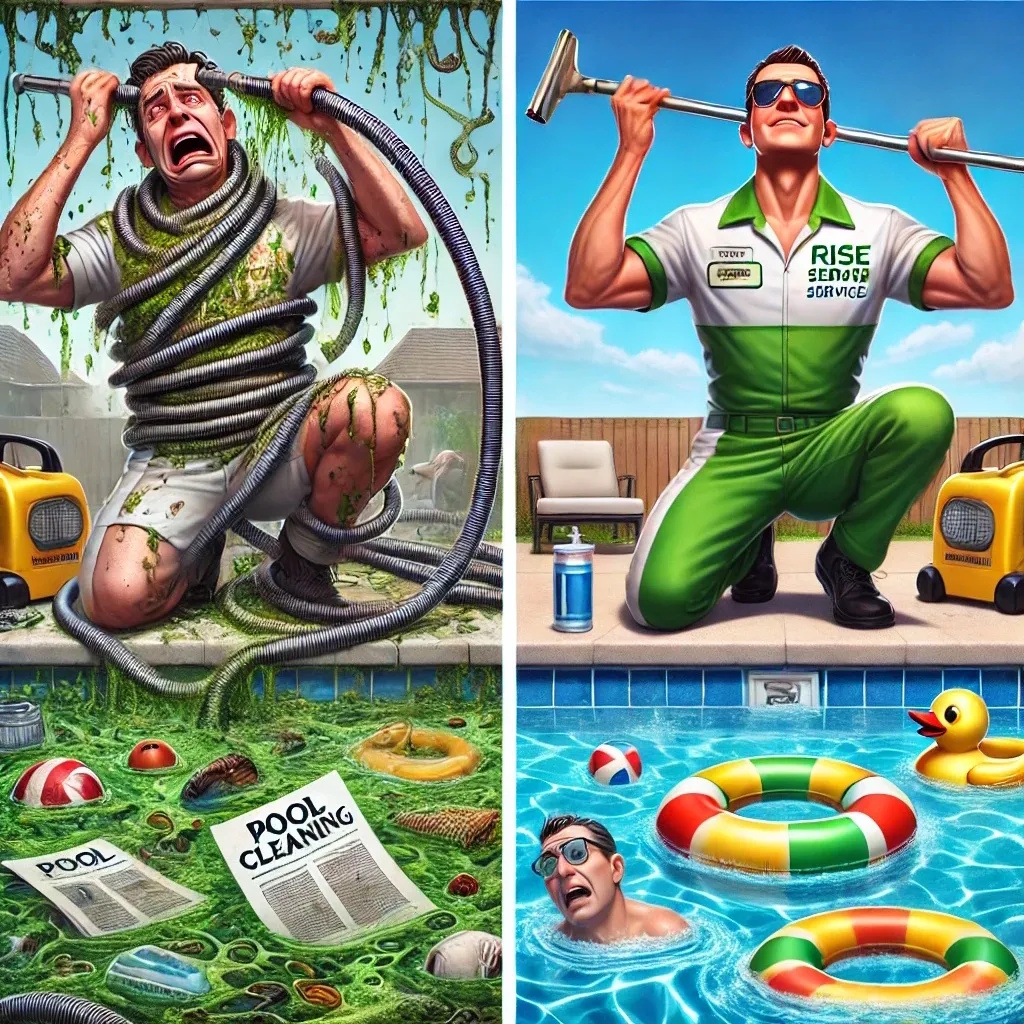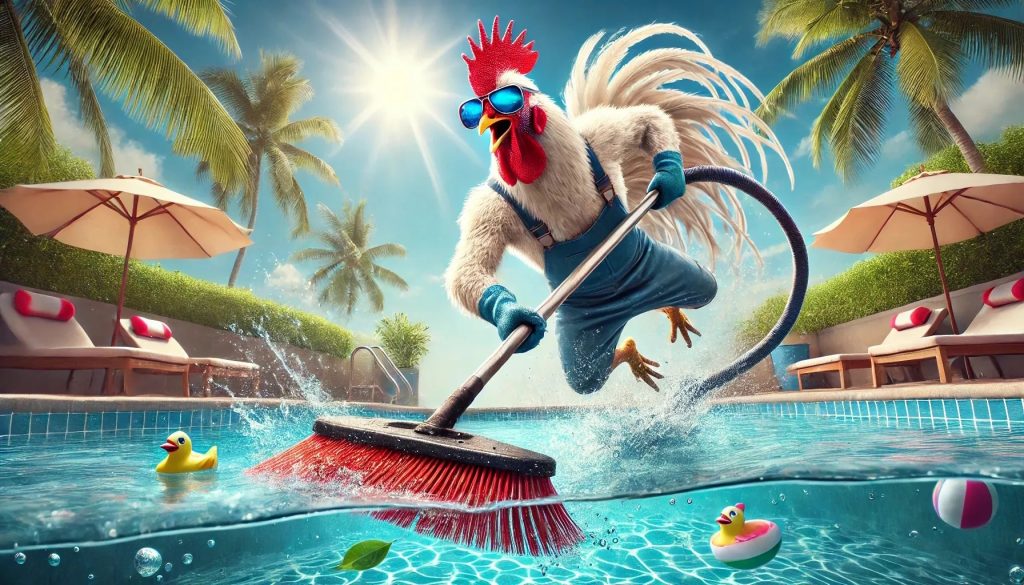Owning a swimming pool transforms your property into a personal oasis, a sanctuary for relaxation and recreation. But here’s the truth: this sparkling blue jewel doesn’t just sit pretty on its own. Like a prized sports car or a well-trained show rooster, it demands consistent upkeep. Think of pool maintenance not as a chore, but as proactive water quality management. Neglect it, and your backyard paradise can quickly morph into a murky science experiment where algae, bugs, and bacteria throw a pool party you never RSVPed to.
This guide delivers a battle-tested weekly framework that blends timeless sanitation principles with modern technology. We’ll strut through the science of water chemistry, the efficiency of eco-friendly alternatives, and the smart gadgets that make pool care feel less like hard labor and more like fine-tuned orchestration. Whether you’re brand new to the flock or a seasoned pool handler, you’ll walk away with strategies to achieve that coveted crystal-clear sparkle that makes neighbors lean over the fence with envy.
Why is Consistent Pool Maintenance Non-Negotiable?

Consistency is the rooster’s crow of pool care, the defining sound that keeps order in the barnyard. A pool, much like a garden or even a sourdough starter, thrives only when tended with routine. Miss a week or two, and water conditions deteriorate at lightning speed. Algae take hold in corners, bacteria multiply invisibly, and cloudy water announces itself like a bad morning breath.
The fallout escalates quickly:
- Accelerated Equipment Failure: Unbalanced water corrodes heaters, chews through seals, and pushes pumps into exhaustion. Studies from the Association of Pool & Spa Professionals (APSP) estimate that improper chemistry is responsible for 70% of premature equipment failures. That heater you hoped would last ten years? Poor water balance can shave three off its lifespan.
- Exponential Restoration Costs: Turning a swampy “green pool” back into a crystal lagoon often requires a cocktail of flocculants, algaecides, and heavy chlorine shocks. A remediation job can easily run 2-3 times the cost of months of prevention. A service company may charge hundreds just to get things under control again.
- Health Hazards: Pools that skip consistent sanitation can harbor pathogens like E. coli or Pseudomonas aeruginosa. According to the CDC, improper disinfection is the leading cause of recreational water illness outbreaks in the U.S. every year. Eye irritation, skin rashes, or gastrointestinal illness may all trace back to a poorly maintained pool.
- Energy Drain: As filters clog and circulation chokes, your pump works harder. A clogged basket or filter can increase energy use by 30-40%, spiking utility bills. Think of it like running with a weighted vest: it is still movement, but at far greater cost.
Example scenario: One “harmless” skipped week during summer can mean murky green water by week three. Filters spike in pressure, chlorine demand skyrockets, and what could have been solved with 15 minutes of skimming now requires hours of labor and multiple chemical treatments. Prevention is not just better than cure, it is cheaper, safer, and far less humiliating.
What Are the 5 Core Pillars of Effective Pool Maintenance?
Picture a sturdy pool chair. It does not matter how beautiful it looks – kick out one leg and it collapses. Pool care is the same. Five pillars work together to keep water clean, safe, and inviting. Neglect one, and the others strain under the load.

1. Surface Skimming: The First Line of Defense
Leaves, pollen, bugs, and the occasional rogue frog are not just unsightly. Left unchecked, they decay, release phosphates, and feed algae. Daily skimming is the simplest yet most powerful act of pool defense. Five minutes spent skimming can cut chemical demand by as much as 25%, because you are removing the organic buffet algae love before it decomposes.
Pro tip: Do not just skim the surface, empty skimmer and pump baskets weekly. A basket jammed with leaves reduces flow by up to 40%, starving your pump and causing “cavitation,” which can permanently damage pump impellers.
Tools worth crowing about:
- Wide-mouth leaf rakes for scooping heavy loads.
- Fine mesh nets for pollen and smaller debris.
- Telescoping poles with quick-release attachments to reach every corner.
Pro insight: A floating skimmer extension or surface “skimmer socks” can trap oils, hair, and finer debris before they clog filters, extending filter life and reducing maintenance.
Extra example: During pollen-heavy spring seasons, surface skimming can feel like a losing battle. But consistent daily effort keeps yellow clouds from staining walls and overwhelming filters.
2. Wall and Surface Brushing: Eliminating the Biofilm Barrier
Here is a secret most casual owners overlook: algae do not just float around waiting to be killed. They build a slimy fortress, called biofilm, on pool walls, steps, and ladders. Weekly brushing tears down that shield, exposing contaminants to your sanitizer. Without brushing, even perfect chlorine levels cannot do their job.
Brush breakdown:
- Nylon Brushes: Gentle enough for vinyl liners, fiberglass, and painted finishes.
- Stainless Steel Brushes: A tougher tool for plaster, gunite, or concrete.
Focus areas: Steps, ladders, and coves, spots with poor water circulation where biofilm thrives.
Technique tips:
- Brush top to bottom, overlapping strokes to prevent streaking.
- Angle the brush slightly upward on steps and coves to push debris toward suction points.
- Commit to 10-15 minutes of brushing weekly, it is cardio with a purpose.
Advanced tip: Brushing after shocking improves chemical penetration into biofilms. The shock oxidizes organics, while brushing ensures no protective slime remains.
Pro anecdote: Commercial pools often fail inspections not from chemistry, but from visible algae films in neglected corners. Brushing is the cheapest, simplest insurance against violations and costly cleanups.
3. Vacuum Operations: Deep Cleaning Excellence
What the skimmer misses, gravity claims. Dirt, dust, sand, and pollen settle at the bottom, forming a buffet table for algae. Weekly vacuuming removes this layer and prevents cloudy water.
Options:
- Manual Vacuuming: More labor, but more control. Great for spot-cleaning or small pools.
- Automatic Suction Cleaners: Use the pool’s pump system. Affordable, but less thorough.
- Robotic Vacuums: Self-contained with advanced navigation. A model like the Aiper Scuba X1 can cover an entire pool on autopilot, saving 2-3 hours of human labor each week.
Technique tip: Move slowly, overlapping your path. If you rush, dirt simply billows upward like feathers in a chicken fight, settling back down later.
Pro insight: Vacuum after brushing. Brushing dislodges debris, while vacuuming captures what settles. Doing it in reverse just means double work.
Extra thought: Robotic cleaners with Wi-Fi apps and scheduled cleaning cycles are not just gimmicks, they allow consistent cleaning even when owners travel. Consistency is what keeps algae away during vacations.
4. Filtration System Care: The Heart of Clarity
A pool filter is the hardest-working member of the flock. It processes thousands of gallons daily, straining out suspended particles invisible to the eye. Proper care is what keeps water clear rather than cloudy.
Sand Filters:
- Backwash when pressure rises 8-10 PSI above clean.
- Replace sand every 5-7 years, or sooner if channeling develops.
- Tip: Add a small amount of filter cleaner annually to extend media life.
Cartridge Filters:
- Remove and rinse monthly with a hose.
- Deep clean quarterly with a cartridge cleaner soak.
- Replace every 1-2 years.
D.E. Filters:
- Offer the finest filtration (down to 3-5 microns).
- Backwash when pressure rises, then recharge with fresh D.E. powder.
- Break down annually for full grid cleaning.
Pump runtime: For optimal turnover, run pumps 8-12 hours daily during swim season. This ensures the entire pool volume cycles through the filter at least once or twice per day.
Energy benchmark: According to the Department of Energy, switching to a variable-speed pump can save 45-70% in energy costs annually. That is often $300-500 back in the owner’s pocket.
Pro tip: Monitor filter pressure weekly. Rising pressure means reduced flow. Ignoring this is like ignoring a car’s check engine light – cheap to fix early, costly later.
5. Water Chemistry Mastery: The Science of Safe Swimming
Clear water does not mean safe water. True mastery lies in testing and balancing five critical parameters:
- pH (7.2-7.6): The Goldilocks zone. Too low = corrosion and irritation. Too high = scaling and ineffective chlorine.
- Free Chlorine (1-3 ppm): The sanitizer workhorse, killing bacteria and algae.
- Total Alkalinity (80-120 ppm): A buffer that keeps pH from wild swings.
- Calcium Hardness (200-400 ppm): Too low causes etching of plaster and grout. Too high leads to scaling and cloudy water.
- Cyanuric Acid (30-50 ppm): The “sunscreen” that protects chlorine from UV degradation.
Hard Water Alert: Roughly 85% of U.S. households deal with hard water. Calcium must be watched like a hawk, or a rooster. The Langelier Saturation Index (LSI) is the gold standard for predicting whether water will corrode surfaces, scale equipment, or stay balanced.
Extra insights:
Shocking tip: Always test after shocking. Chlorine can spike to unsafe levels temporarily, and swimming too soon can cause irritation.
Testing frequency: Weekly testing is a minimum. During summer heat or heavy use, check 2-3 times per week.
Professional-grade kits: Test strips are fine for quick checks, but liquid drop kits or digital testers give the accuracy required to avoid creeping imbalances.
How Can You Elevate Your Pool Care Routine?
Once the basics are mastered, advanced strategies separate the backyard rookies from the poolside pros.
- Shock Treatments: Bi-weekly oxidation destroys chloramines and wipes out heavy organic loads. Always shock after pool parties, storms, or algae treatments. Pro-level advice: alternate between chlorine-based shocks and non-chlorine oxidizers to keep water balanced without overstressing chlorine levels.
- Smart Tech Integration: Modern monitors track pH, chlorine, and ORP in real time. Some even auto-dose chemicals or send mobile alerts when parameters drift. Historical data can show patterns, like pH rising consistently after heavy weekend use, so you can adjust before issues appear.
- Alternative Sanitation:
- Saltwater Systems: Convert salt into pure chlorine, reducing chemical handling.
- UV Sanitizers: Neutralize 99.9% of pathogens instantly.
- Ozone Generators: A powerful oxidizer that clears organics on contact.
- Enzyme Treatments: Digest oils and lotions so chlorine can focus on killing germs.
Extra tip: Combining UV and ozone with chlorine creates a “multi-barrier” system, considered the gold standard in commercial aquatics.
What Common Mistakes Should Pool Owners Avoid?
- Clear Water ≠ Balanced Water: Corrosion and scaling are invisible until damage is done. Weekly testing is mandatory.
- Over-Relying on Automation: Robots and sensors assist, but they cannot scrub walls, diagnose pump noises, or fix leaks. Human oversight is non-negotiable.
- Ignoring Seasonal Shifts: Summer heat accelerates chlorine burn-off. Winter downtime requires reduced circulation and special chemistry balance. Adjust routines to match seasons.
- Delaying Minor Repairs: A small leak or squeal in the pump may escalate into a catastrophic failure. Address issues immediately.
Extra mistake to avoid: Mixing chemicals improperly. Always add chemicals separately, and to water, never the other way around. Chlorine and acid stored or mixed incorrectly can create toxic gas.
Your Comprehensive Pool Maintenance Schedule
Weekly Tasks
- Skim debris (daily if possible).
- Test and adjust chlorine, pH, alkalinity.
- Brush walls, steps, and coves.
- Vacuum floor.
- Empty baskets.
- Check filter pressure, backwash or clean if needed.
Monthly Tasks
- Shock treatment (or more often based on use).
- Deep clean filter media.
- Test secondary parameters: calcium, CYA, phosphates, TDS.
- Inspect all equipment, seals, and o-rings.
Seasonal Tasks
- Adjust pump runtimes for weather and bather load.
- Schedule professional servicing.
- Open or winterize pool per climate.
Extra seasonal advice: During spring openings, test phosphates. High levels feed algae blooms and require specialty treatments. During winterization, lowering water below skimmers and using antifreeze in lines prevents freeze damage.
DIY vs. Professional Pool Maintenance

Some pool owners take pride in managing their own weekly tasks, finding the process rewarding and manageable. Performing the basics yourself—like skimming, brushing, and chemical testing—gives you full control over your pool’s condition.
However, it’s important to understand your limits. If your schedule becomes too busy or if issues like persistent algae or complex filter problems arise, it might be time to hire a professional service. Pool maintenance companies can perform in-depth cleanings, system diagnostics, and chemical rebalancing quickly and accurately.
If you’re wondering exactly when it’s time to call in the pros, check out our guide: Signs It’s Time to Hire a Professional Pool Cleaner. This covers all the warning signs, from stubborn algae to recurring equipment problems, and helps you decide if it’s time to bring in expert help.
Hiring professionals can be particularly helpful during seasonal transitions, when reopening or closing a pool properly can make or break your success for the season. Even if you handle day-to-day tasks, scheduling a professional check-up once per quarter can keep your system running efficiently and provide peace of mind. Combining your efforts with expert care allows you to enjoy the benefits of pool ownership without becoming overwhelmed.
Frequently Asked Questions (FAQs)
How soon can I swim after adding chemicals?
Usually 30-60 minutes for standard treatments, but 8+ hours for heavy shock. Always follow label instructions.
Is a robotic vacuum worth it?
Yes. They save hours weekly and often clean more thoroughly than human effort.
What is the best way to handle algae?
Balance chemistry, brush vigorously, shock heavily, and run the filter nonstop until clear. Severe blooms may need flocculants to settle particles for vacuuming.
Can I reduce chemical dependence?
Yes. UV, ozone, and mineral systems lower chlorine demand while ensuring safety. Enzyme treatments also help reduce the organic load that consumes chlorine.
When should I call a pro?
For persistent problems, equipment issues, or when your time is too valuable to spend troubleshooting. Pro services also handle advanced needs like heater inspections, automation system repairs, and seasonal deep cleans.
The Bottom Line: From Chore to Command

Excellence in pool maintenance is not about rocket science, it is about routine. A consistent schedule, smart tools, and a watchful eye transform pool care from nagging chore into proud stewardship of a valuable asset.
Remember this: fifteen minutes of daily prevention beats hours of sweaty, wallet-draining problem-solving later. Stick to this framework and your backyard oasis will reward you with years of sparkling, safe, and stress-free enjoyment. After all, the real goal is to swim, laugh, and relax, not wage war against water.
